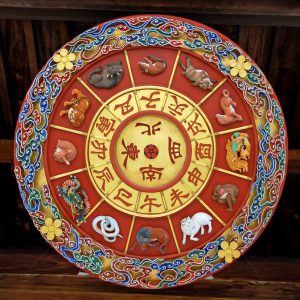
The Ōkami Video Game Characters

The Ōkami video game is deceptively big; almost as if Ōkami’s creators enjoyed lulling players into a sense of achievement when finally reaching the ending, only for them to realise the story hadn’t even fully begun yet. Saving the world isn’t a quick and easy job, after all.
Such a big world is going to need plenty of characters to fill it, and Ōkami certainly delivers.

This video game’s characters aren’t just crowd fillers, but can be interacted with and react to being approached, barked at, tugged on, rained on, gusted away, bumped into and more.
Ōkami has a story that requires certain tasks to be achieved before the player can progress, however this is not a hindrance or even distractingly obvious.
It’s so easy to lose oneself in each chapter of Ōkami’s story, with many discoveries to be made and also entertaining side-quests to take part in.

Each character has an obvious and distinct personality, and a story to tell which clearly they don’t mind sharing with a beautiful white wolf that just happens to be walking by. Wolves were regarded as messengers of the gods in ancient Japan,1 https://en.wikipedia.org/wiki/Japanese_wolf
https://en.japantravel.com/saitama/lost-sacred-wolves-and-wolf-worship/46262 so when Ammy (the wolf) enquiringly walks up to a video game character then most times they’ll be friendly and share their innermost hopes and troubles.
As the player who’s controlling Ammy, you can then choose to help each of the characters in some way or leave them be:
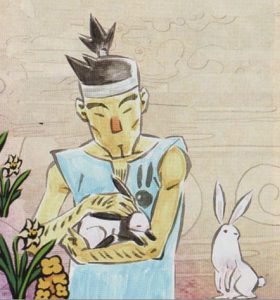
Some examples are finding the beloved pet rabbit of an animal lover, who is sad from not being able to find it, or buying costly medicine for the ailing father of a distraught and helpless young woman caring for him. These are optional side-missions, that will earn Ammy praise, which then can be used to increase her divine powers.
Other interactions of this kind are integrated into Ōkami’s story, such as rescuing a bamboo cutter’s daughter (based on an ancient Japanese tale) and helping a boy on his mission of becoming a strong man (in body, mind and soul) like his father.
Such quests, most of which are optional, help the player feel more important and part of the greater overall story. The characters are very much suited to the environment they’re in, and thus, the player in his or her interaction with them through Ammy, becomes a part of that environment and its rhythm and history. If one character doesn’t pull you into Ōkami’s story, then quite likely there’s another character that will.
Ōkami’s Main Characters
Who is “Ammy”, and what’s a Poncle? Here’s a quick set of facts about the main characters to help get you up to speed:
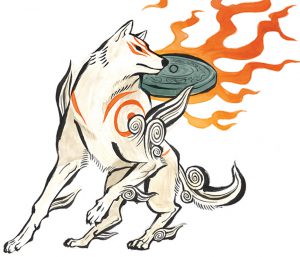 Ōkami Amaterasu (“Ammy”), Brush God(dess) – The Japanese sun goddess in the form of a white wolf, and is the main character controlled by the video game’s player. Called upon by the earthbound tree spirit Sakuya, to save the land of Nippon (ancient mythical Japan) from complete destruction by demons, and to restore its nature, life and beauty.
Ōkami Amaterasu (“Ammy”), Brush God(dess) – The Japanese sun goddess in the form of a white wolf, and is the main character controlled by the video game’s player. Called upon by the earthbound tree spirit Sakuya, to save the land of Nippon (ancient mythical Japan) from complete destruction by demons, and to restore its nature, life and beauty.
Also known as the white wolf “Shiranui”, one hundred years prior to the events of Ōkami’s main story: The sun goddess’ wolf incarnation (then known as Shiranui) body had succumbed to the wounds received during her ultimately victorious battles against demons.
The most powerful of Ōkami’s “fifteen Brush Gods” (wielding a “brush” to paint divine power onto the “canvas” of reality). Ammy draws upon mankind’s faith in the gods as her true source of divine power.
The Ōkami video game finds much inspiration from Japanese folklore, religion, places and objects:
 The flaming “reflector” (called “Divine Retribution”) above Ammy’s back is based on the mirror “Yata no Kagami”,2 (https://en.wikipedia.org/wiki/Yata_no_Kagami) which is one of the three “Imperial Regalia of Japan”,3 (https://en.wikipedia.org/wiki/Imperial_Regalia_of_Japan) also known as the “Three Sacred Treasures”.
The flaming “reflector” (called “Divine Retribution”) above Ammy’s back is based on the mirror “Yata no Kagami”,2 (https://en.wikipedia.org/wiki/Yata_no_Kagami) which is one of the three “Imperial Regalia of Japan”,3 (https://en.wikipedia.org/wiki/Imperial_Regalia_of_Japan) also known as the “Three Sacred Treasures”.
The character “Ammy” is based on the Japanese goddess “Amaterasu-ōmikami”:4 (https://en.wikipedia.org/wiki/Amaterasu)
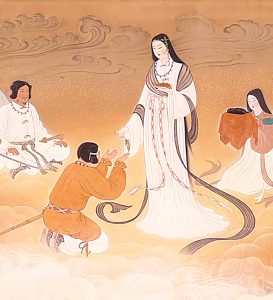 In Japanese Shinto belief (spirit/god/kami-worship), Amaterasu is in the form of a beautiful human woman, and is the sun goddess and ruler of the the gods’ home in heaven (called Takamagahara) and also the ruler of all gods on Earth.
In Japanese Shinto belief (spirit/god/kami-worship), Amaterasu is in the form of a beautiful human woman, and is the sun goddess and ruler of the the gods’ home in heaven (called Takamagahara) and also the ruler of all gods on Earth.
 Wandering Artist “Issun” – A human-like young man, from a race of beings no taller than a human thumb, known as Poncles. These beings can speak the language of both humans and the gods, acting as “Celestial Envoys” to inspire peoples’ faith in the (Brush) Gods. Without mankind’s faith, the gods lose their powers and also their ability to serve and protect life and nature. Being in the form of animals, the gods don’t speak human language and require Celestial Envoys to speak for them.
Wandering Artist “Issun” – A human-like young man, from a race of beings no taller than a human thumb, known as Poncles. These beings can speak the language of both humans and the gods, acting as “Celestial Envoys” to inspire peoples’ faith in the (Brush) Gods. Without mankind’s faith, the gods lose their powers and also their ability to serve and protect life and nature. Being in the form of animals, the gods don’t speak human language and require Celestial Envoys to speak for them.
The words used to describe Issun’s personality wouldn’t be very flattering at the beginning of the story, usually hovering around “selfish”, “immature” and “brash”.
However, just like many characters in this adventure, Issun (very slowly) begins to grasp the more profound facets of life beyond his own self-serving worldview.

Throughout Ōkami’s story, Issun spends his time hitching a ride between Ammy’s ears and speaking for her when required. Ultimately his moment to mature would come, after witnessing the harsh choices (and their consequences) between what is right or what is wrong, made by those around him during his adventure.
This character is based on the folktale of “Issun-bōshi” (One Inch Boy)5 (Wikipedia page on Issun-bōshi:
https://en.wikipedia.org/wiki/Issun-bōshi) – Leaving home as a young (one inch tall) man and armed with only a sewing needle, he bravely saved a princess from two ogres by stabbing at the insides of an ogre who had swallowed him and poking the other ogre in the eye. The ogres dropped their “Lucky Mallet” which had the magical power to turn Issun into a normal-sized man. Issun successfully used the Lucky Mallet, and he and the princess eventually married.
One of the first scenes in Ōkami actually show Ammy swallowing Issun, but quickly spitting him out again, and the video game also features a “Lucky Mallet”.
You can find an illustrated version of the original Issun-bōshi folk tale here:
https://web-japan.org/kidsweb/folk/issun/
Animated and narrated version of the Issun-bōshi folk tale – “Inch Boy – Animation of Japanese Traditional Stories”:
https://www.youtube.com/watch?v=4l2sBFkFxv4
 Tree Spirit (Wood Sprite) “Sakuya” – A powerful (and beautiful) tree spirit residing inside the mighty cherry blossom (Konohana) tree of Kamiki Village – the village in Ōkami where the story begins.
Tree Spirit (Wood Sprite) “Sakuya” – A powerful (and beautiful) tree spirit residing inside the mighty cherry blossom (Konohana) tree of Kamiki Village – the village in Ōkami where the story begins.
As destruction by demonic forces ravaged the world around her, Sakuya managed to use her power to awaken Ammy from her one hundred year slumber, and plead for the land and life to be restored.
A great admirer and friend of Ammy, their powers combined bring back incredibly lush displays of life and nature to cursed lands.
Restoration of Ryoshima Coast: Clover Studio, Capcom
This character is a reference to “Konohanasakuya-hime”,6 (https://en.wikipedia.org/wiki/Konohanasakuya-hime) wife to Amaterasu’s grandson “Ninigi-no-mikoto”, she is a kami/goddess mentioned in the “Kojiki” – an ancient Japanese text dating from the early 8th century.7 (https://en.wikipedia.org/wiki/Kojiki) Also known as “Sakuya-hime”, she is said to be the blossom-princess (her symbol is a sakura/cherry blossom) and the embodiment of the fleeting fragility of earthly human life.
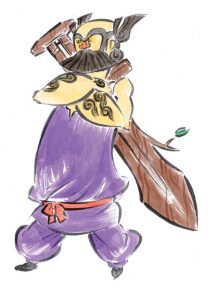 Great Warrior “Susano” - A troubled individual (and drunkard) with all-talk and no substance, who never once in his life lived up to the self-proclaimed title of “Great Warrior”. He lives in Kamiki Village and is secretly in love with Kushi, the local (very beautiful) Sake brewer. This is a character with a lot to live up to, but also in possession of many reasons to gather himself and break through his shortcomings.
Great Warrior “Susano” - A troubled individual (and drunkard) with all-talk and no substance, who never once in his life lived up to the self-proclaimed title of “Great Warrior”. He lives in Kamiki Village and is secretly in love with Kushi, the local (very beautiful) Sake brewer. This is a character with a lot to live up to, but also in possession of many reasons to gather himself and break through his shortcomings.
For various reasons, Susano plays an important role in Ōkami, and Ammy appears to be quite fond and supportive of him despite his many faults.
Susano is a reference to the storm god of Shinto religion and brother of Amaterasu, known as “Susano’o no Mikoto”,8 (https://en.wikipedia.org/wiki/Susanoo-no-Mikoto) “Susanoo” and also other names. Being a very destructive, undisciplined and violent god, Susanoo was eventually banished from Heaven down to Earth by Amaterasu and other gods, but later reconciled and was allowed to return.
On Earth, he had slain the eight-headed dragon “Yamata no Orochi”9 (https://en.wikipedia.org/wiki/Yamata_no_Orochi) in return for marrying “Kushinada-hime”,10 (https://en.wikipedia.org/wiki/Kushinada-hime) who the dragon was demanding as a sacrifice. (Ōkami’s characters “Orochi” and “Kushi” are heavily based on this narrative.)
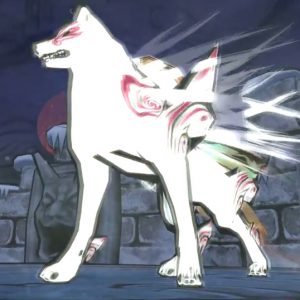 Brush God(dess) “Shiranui” - Just like “Ammy”, Shiranui is the (same) Japanese sun goddess in the form of a white wolf, only this is her incarnation one hundred years prior to Ōkami’s main storyline.
Brush God(dess) “Shiranui” - Just like “Ammy”, Shiranui is the (same) Japanese sun goddess in the form of a white wolf, only this is her incarnation one hundred years prior to Ōkami’s main storyline.
Already at the beginning of Ōkami, the player finds out that Shiranui was Ammy’s previous incarnation.
Ōkami’s spinoff video game (for the Nintendo DS) Ōkamiden had altered the story to make Shiranui into the grandfather of “Chibiterasu” – the main character of Ōkamiden, and Ammy’s son.
Various contradictions in Ōkamiden’s story have caused some confusion amongst gamers. This fansite will therefore stay true to the original story of Ōkami, and also assume that the wolf incarnation (Ammy/Shiranui) of a female human-form Japanese sun goddess (Amaterasu-ōmikami) would most likely remain female.
Spoiler: Ammy and Shiranui are the same: Clover Studio, Capcom
Categories of Ōkami’s Characters
Instead of listing all characters (over two hundred!) or just the main ones and ignoring the rest, this paragraph will try to group them loosely into categories. Ōkami also has many different plants and wildlife, that make up part of the “living” world of Nippon (ancient mythical Japan) within the video game.
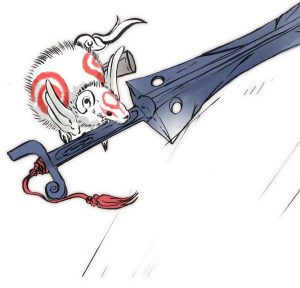 Brush God (A rat named “Tachigami”) – One of the fifteen animal “Brush Gods”, this one wielding the “Power Slash” brush technique (a single divine power) – allowing the technique’s wielder to slash through objects, as well as demonic enemies.
Brush God (A rat named “Tachigami”) – One of the fifteen animal “Brush Gods”, this one wielding the “Power Slash” brush technique (a single divine power) – allowing the technique’s wielder to slash through objects, as well as demonic enemies.
Each Brush God possesses only a single brush technique, with Ammy being the only one capable of possessing all of them.
The Brush Gods (metaphorically) wield a “brush” to paint divine power/miracles onto the “canvas” of reality.
Painting the sun; making daytime: Clover Studio, Capcom
Ōkami’s fifteen Brush Gods are mainly based on the twelve animals of the Japanese Zodiac:
Rat – Tachigami, Ox – Itegami, Tiger – Gekigami, Rabbit – Yumigami, Dragon – Yomigami, Snake – Nuregami, Horse – Kazegami, Sheep – Kasugami, Monkey – Sakigami/Hasugami/Tsutagami (three brush gods counted as one), Rooster – Moegami, Dog – Ammy (a wolf), Boar – Bakugami, Cat – Kabegami (the cat exists in the Vietnamese Zodiac in place of the rabbit).
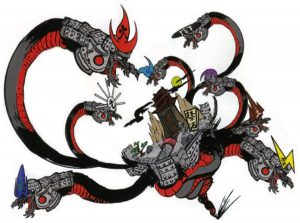 Demonic Enemy (“Orochi”) – One of the very many demonic enemies, with this particular one being a major part of Ōkami’s story. Orochi is not easy to defeat, as all its heads will need to be slain in turn and each require a different combat technique.
Demonic Enemy (“Orochi”) – One of the very many demonic enemies, with this particular one being a major part of Ōkami’s story. Orochi is not easy to defeat, as all its heads will need to be slain in turn and each require a different combat technique.
Based on the legendary Japanese eight-headed dragon “Yamata no Orochi”11 (https://en.wikipedia.org/wiki/Yamata_no_Orochi) who was slain by Susanoo, this foul creature is only one of many monsters described in ancient Japanese texts.
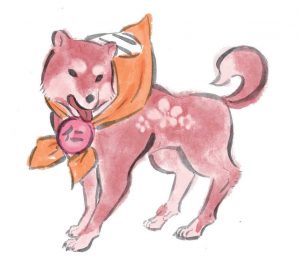 Earthbound Warrior (“Canine Warrior Jin”) - One of Ōkami’s earthbound warriors (on the side of good), of which there are either animals or humans, as well as humans that can transform into animals and back again at will.
Earthbound Warrior (“Canine Warrior Jin”) - One of Ōkami’s earthbound warriors (on the side of good), of which there are either animals or humans, as well as humans that can transform into animals and back again at will.
Whether animal or human, these warriors share apparently human intelligence, motivations and character faults – however when in the form of animals, they can only communicate with other animals and Poncles such as Issun.
Most of the earthbound warriors in Ōkami are based some kind of Japanese mythology, folklore or novel – in this case, Jin belongs to “The Eight Canine Warriors” as they’re known in Ōkami, who are based on the Japanese epic novel “Nansō Satomi Hakkenden” (The Eight Dog Chronicles, but also known by similar translations.)12 (https://en.wikipedia.org/wiki/Nansō_Satomi_Hakkenden)
This epic novel (106 volumes) was written and published between 1814 – 1842, and is apparently one of the most popular novels in Japan.
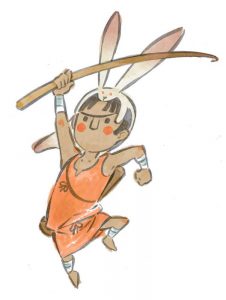 Everyday Human (“Boy of the Forest, Kokari”) – One of Ōkami’s many everyday humans inhabiting Nippon. Each with their own profession or hobby, motivations and character. From people living off the land to city-dwellers and aristocrats, Nippon’s inhabitants are a varied bunch for sure!
Everyday Human (“Boy of the Forest, Kokari”) – One of Ōkami’s many everyday humans inhabiting Nippon. Each with their own profession or hobby, motivations and character. From people living off the land to city-dwellers and aristocrats, Nippon’s inhabitants are a varied bunch for sure!
Kokari doesn’t appear to be based on a specific mythical character, rather he is a young boy on the sometimes bumpy journey of growing into a man. As the story of Ōkami progresses, we see Kokari grow in confidence and set out to discover more of the world around him, with his protective and loyal dog by his side.
 Common Animal (Rabbit) - One of the many common animals inhabiting Nippon. These animals make up part of the natural plants and wildlife in the Ōkami video game universe.
Common Animal (Rabbit) - One of the many common animals inhabiting Nippon. These animals make up part of the natural plants and wildlife in the Ōkami video game universe.
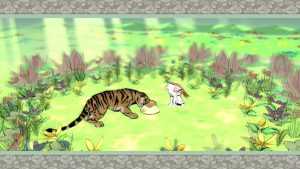 There are many animals to see (such as horses, bears, dogs, birds, tigers, rabbits, pigs, deer, foxes and more), and these animals can also be fed by Ammy.
There are many animals to see (such as horses, bears, dogs, birds, tigers, rabbits, pigs, deer, foxes and more), and these animals can also be fed by Ammy.

As Ammy has taken it upon herself to restore Nippon to its former beauty (before it was overrun and wrecked by demons), feeding these many animals is an important part of that process.
Ōkami even has a context-sensitive “feed the animals” button. Once the animals have been fed (by food which has been found or bought from merchants), the animals will give their praise to Ammy, resulting in her powers increasing.
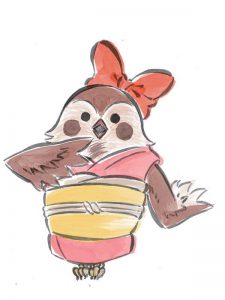 Anthropomorphic Animal (“Flower of Sasa Sanctuary, Chun”) - Non-warrior anthropomorphic animals; they generally don’t engage in combat and appear to have human characteristics such as human-level intelligence, speech or mannerisms.
Anthropomorphic Animal (“Flower of Sasa Sanctuary, Chun”) - Non-warrior anthropomorphic animals; they generally don’t engage in combat and appear to have human characteristics such as human-level intelligence, speech or mannerisms.
These anthropomorphic animals also appear to have everyday professions, motivations and characters, however they generally don’t interact or congregate with humans in a casual or open manner. Instead, all interaction with humans appears to be in a professional capacity, such as in the case of “Chun”, who belongs to the “Sparrow Clan”: A clan of human-sized sparrows who own and operate the Sasa Sanctuary – a resort, inn and bath house that can only be seen and accessed by those with a pure heart.
The Sparrow Clan are based on the sparrows in the folk-tale called “Shita-kiri Suzume” or “Tongue-Cut Sparrow” in English.13 (https://en.wikipedia.org/wiki/Shita-kiri_Suzume) This Japanese folk-tale exemplifies the moral message of good deeds being rewarded with more good, and evil or selfish deeds resulting in misfortune.
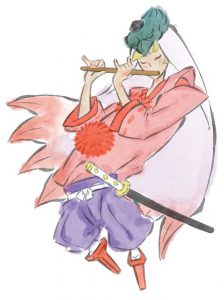 Mysterious Human(oid) (“Tao Master Waka”) - One of the many human/humanoid beings of a more mysterious or otherworldly origin. These human-like beings are more advanced or powerful in some form, than the everyday people of Ōkami’s Nippon.
Mysterious Human(oid) (“Tao Master Waka”) - One of the many human/humanoid beings of a more mysterious or otherworldly origin. These human-like beings are more advanced or powerful in some form, than the everyday people of Ōkami’s Nippon.
In the story of Ōkami, those unusual beings inhabit a palace under the sea (the Dragonians), and used to inhabit the moon (the Moon Tribe) and the Celestial Plain (the Celestials).
In the case of Waka, he is a member of the almost-extinct Moon Tribe – which appears to have been based on a version of the 10th-century Japanese folktale “Taketori Monogatari” (The Tale of the Bamboo Cutter).14 (https://en.wikipedia.org/wiki/The_Tale_of_the_Bamboo_Cutter)
Ōkami’s Main Locations
Lots of characters need lots of room to move, work and live. Let’s see the main locations mentioned in Ōkami:
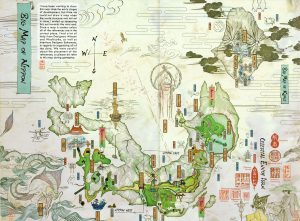 Nippon - Ancient mythical Japan, covering vast areas and locations from beneath the sea to high up mountains and towering constructions. It will take even the most hardcore of gamers many hours to discover every part of Ōkami’s Nippon.
Nippon - Ancient mythical Japan, covering vast areas and locations from beneath the sea to high up mountains and towering constructions. It will take even the most hardcore of gamers many hours to discover every part of Ōkami’s Nippon.
In a way, Nippon is also representative of the entire/known (at the time) world, because the Brush Gods are responsible not only for Nippon, but the harmony of the entire world.
Various locations of Ōkami’s Nippon borrow names or features and landmarks of real-world Japan, blending in features and places described in mythology and folklore, to create an idealised version of ancient Japan. Nippon’s inhabitants have in recent generations, generally stopped believing in the (Brush) Gods – however still remaining in tune with the worldly natural life that surrounds them, and generally taking part in rituals associated with kami/god/spirit worship.
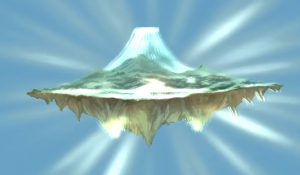 The Celestial Plain – Home of various unnamed gods, the Celestials and Ammy who is the ruler of the Celestial Plain. Even though this location cannot be visited during the game, as the player progresses it becomes clear that the Celestial Plain is a major part of Ōkami’s story. Preceding the story of Ōkami, terrible destruction had been wreaked upon the Celestial Plain.
The Celestial Plain – Home of various unnamed gods, the Celestials and Ammy who is the ruler of the Celestial Plain. Even though this location cannot be visited during the game, as the player progresses it becomes clear that the Celestial Plain is a major part of Ōkami’s story. Preceding the story of Ōkami, terrible destruction had been wreaked upon the Celestial Plain.
Known as “Takamagahara” in Shinto belief,15 (https://en.wikipedia.org/wiki/Takamagahara) Ōkami’s Celestial Plain is heavily based on ancient Japanese texts describing it. Home of the deity/gods of creation and the heavenly gods, who rule over the earthly gods in order to bring harmony to the world.
The Moon – Original home of the Moon Tribe, it’s a location only ever mentioned in Ōkami and remains shrouded in mystery. Nevertheless, the Moon and the events surrounding its inhabitants play a significant role in the misery inflicted upon the lives of Ōkami’s blameless characters.
Ammy, with the support of other characters in the story, is the only one who can end this misery and restore peace and harmony not only to Nippon, but also the Celestial Plain. The Moon itself, appears to have been abandoned of all life after a cataclysmic event in its past, and would no longer be the subject of restoration.
In Shinto, Tsukuyomi is the moon god and brother to Amaterasu.16 (https://en.wikipedia.org/wiki/Tsukuyomi-no-Mikoto) Being condemned by his sister as evil after he slew the goddess of food Ukemochi in a fit of rage, she demanded never to see him again, which is why the sun and the moon (day and night) are separate from each other.
More information
For greater insight into the characters and their personalities, you can visit the Ōkami wiki pages that go into further detail:
Fandom.com: https://okami.fandom.com/wiki/Category:Characters_in_Ōkami
Generally, it would appear that to Japanese people, Shinto is more a “way of life” rather than a religion, and that calling it “kami-worship” may be a more accurate description. Kami may best be described as “gods/spirits”. To simplify the explanations on this fansite, words more familiar to Western audiences like “Shinto religion” and “gods” will be used.
This isn’t an easy subject, and if you want to know more about Japanese Shinto, mythology and folklore, the following links may be a good starting point:
Encyclopedia of Shinto: http://k‑amc.kokugakuin.ac.jp/DM/dbTop.do?class_name=col_eos
(More links in the next update)
Hi! We’re still working on expanding this page a bit. If you’d like to make suggestions, please see the contact page.
- Adding more citations
- Mentioning additional characters such as the Oina Tribe, Moley, Orca and Benkei
- Adding more character drawings in the categories section, to help clarify and separate them.
See our Planned Updates & Updates Log blog post for more details.
Share this page:
Sources:
- TBA
Header image is a montage of official Clover Studio and Capcom Ōkami artwork. All character drawings are official Clover Studio/Capcom artwork. Image of moon found on Ōkami’s Fandom Wiki page and slightly edited. Screenshot of “Kokari lost his dog” from video on YouTube.
Additional sources, and how we choose and link sources: Website Art, Graphics & Other Sources, Plus Posting & Linking Policies
Consider Basic Internet Browsing & Safety Tips, when visiting these and other websites. No links to other websites are affiliate links: advice is 100% free & independent.

